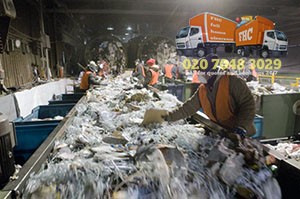As predicted, successful recycling programs depend on sufficient and steady supply or stream of recyclable waste. The basic aim (not purpose) of a recycling program is to create useful raw materials from junk and rubbish. To narrow the thesis – properly cleaned, sorted and separated recyclable waste will produce higher quality recyclates, which in turn will help produce higher quality end products and materials.
 Sorting of waste, much like rubbish removal itself, has always been somewhat of a problem, as in the past sorting was done manually, or using very rudimentary sorting technologies. With technological advancements (which also spill into more efficient waste removal and disposal), sorting waste has also become highly efficient. Nowadays, some of the more advanced soring systems in use can separate the recyclables in a truckload of waste from general garbage, in less than an hour.
Sorting of waste, much like rubbish removal itself, has always been somewhat of a problem, as in the past sorting was done manually, or using very rudimentary sorting technologies. With technological advancements (which also spill into more efficient waste removal and disposal), sorting waste has also become highly efficient. Nowadays, some of the more advanced soring systems in use can separate the recyclables in a truckload of waste from general garbage, in less than an hour.
After rubbish collection, waste is transported to specialised treatment or sorting facilities also known as processing or recycling depots. Waste separation has many different stages as there are different types of recyclables to be separated and extracted for further processing.
At the moment, single stream recycling (single stream recycling plants) are perhaps the most efficient and reliable way to separate and extract useful waste from mainstream rubbish. The technology and equipment used in such facilities allows for the effective separation of all recyclables, even batteries. Since these single stream recycling facilities have been operational, countries which use them have noted a thirty percent increase in recycling rates.
The process begins with manual removal of plastic bags and corrugated cardboard from the commingled stream of waste delivered to the plant after rubbish removal from the public. Such waste needs to be removed as it causes separating equipment malfunction.
Next stage is weight sorting – a machine weighs the rubbish while on the conveyor belt and separates different types of rubbish depending on their weight. This sorts plastic and paper, from heavier recyclables like metal and glass. Cardboard and common types of plastic are removed manually from the now separated ‘light’ waste stream. Modern examples of this separation stage use infrared scanners which ‘see’ the difference between various types of paper and plastic waste thus they redirect their streams around the plant. These machines are known as spectroscopic scanners and determine which waste is what, by measuring the absorption of IR rays they emit.
For separating ferrous from nonferrous metals, recycling plants use strong magnetic fields which attract and separate all ferrous metals. Nonferrous metals (those which aren’t attracted by magnets) are ejected from the stream by what’s called a rotational magnet eddy current. In simple terms, the rotating electromagnetic field causes nonferrous metals to be ejected off the stream thus separated.
For separating different types of glass, depots either use human workers or special machines which have special coloured filters that distinguish between brown, green, amber, clear and other coloured glass. However glass shards of less than ten millimetres across cannot be separated and are usually added altogether to form a recyclable glass material known as glass-fine.



